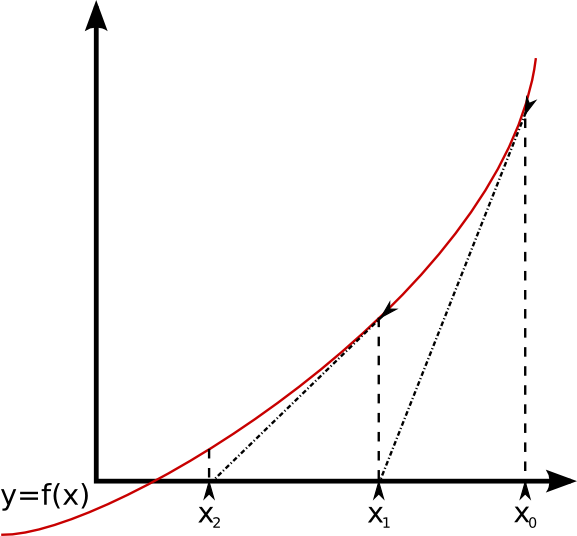Newton Raphson method of root aproximation

The Newton Raphson method finds successively better approximations to roots of the real valued function \( f(x) = 0 \).
Refer to the above image. We start off with the approximate root , find the value of , take the tangent to the curve, which results in the approximate root . We continue this process, find the value of , take the tangent to the curve, which results in the approximate root . By continuing the process, we should reach the actual root , to a great degree of accuracy.
Let's write this down in equation form. We start off with a first approximation, which is denoted by . Then, we consider the point , which has a slope of , hence the equation of the tangent is
and the intersection with the x-axis occurs when , or that
We repeat this process with
until a sufficiently accurate value is reached.
Find the value of as the root of the equation , using the starting value of . Note that all values of will be rational numbers, hence we get a sequence of rationals which approximate the value of the irrational number .
Easy Math Editor
This discussion board is a place to discuss our Daily Challenges and the math and science related to those challenges. Explanations are more than just a solution — they should explain the steps and thinking strategies that you used to obtain the solution. Comments should further the discussion of math and science.
When posting on Brilliant:
*italics*or_italics_**bold**or__bold__paragraph 1
paragraph 2
[example link](https://brilliant.org)> This is a quote# I indented these lines # 4 spaces, and now they show # up as a code block. print "hello world"\(...\)or\[...\]to ensure proper formatting.2 \times 32^{34}a_{i-1}\frac{2}{3}\sqrt{2}\sum_{i=1}^3\sin \theta\boxed{123}Comments
Ahh!? Finally, there is someone here make a note about this topic. Now, using the Newton-Raphson method, try to answer these problems:
Simultaneous Linear Equations
Simultaneous Non-Linear Equations
Computational Physics (Mechanical System)
Good luck!! (^_^)
Ugh!!I wanted to make a note on this topic....but you beat me to it!!Nicely presented btw!!
Log in to reply
Thanks! I wanted to create problems on the Newton Raphson method, and highlight the cases when it failed, as those were interesting to me.
I found that explaining this method in the problem made it too long, so I separated it out into a note, and will link it from there. Problems should be posted soon :)
Here, f(x) = x^2 - 2 and f’(x) = 2x
Now, f(0)=-2
hence, the root lies between 1 and 2.
Let, x0 = 1
x1 = x0 – { f(x0) / f’(x0)}
Similarly,
x2 = 1.4166
x3 = 1.4142
x4 = 1.4142
hence, √2 = 1.4142
IS BISECTION METHOD AND REGULA-FALSI METHOD SAME OR DIFFERENT..???
Isnt it better to use it to approximate roots of higher degree equations than finding square roots?